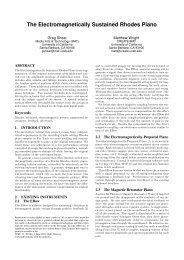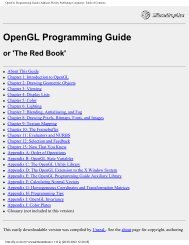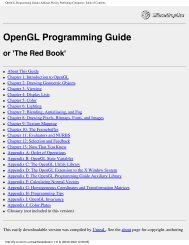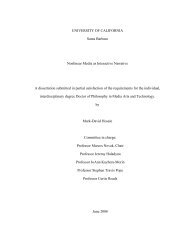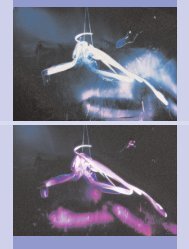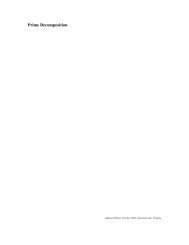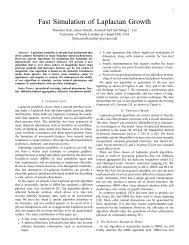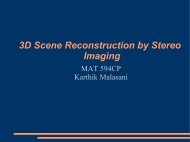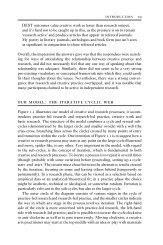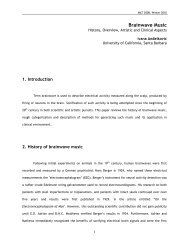Course Presentation Slides - Media Arts and Technology
Course Presentation Slides - Media Arts and Technology
Course Presentation Slides - Media Arts and Technology
You also want an ePaper? Increase the reach of your titles
YUMPU automatically turns print PDFs into web optimized ePapers that Google loves.
MAT 594O: Sensors <strong>and</strong><br />
Interfaces for <strong>Media</strong> Art<br />
Formerly “<strong>Media</strong> Interface <strong>Technology</strong>”<br />
UCSB, Winter, 2010<br />
Instructors<br />
Stephen Pope, Javier Villegas, Matt Wright<br />
http://www.mat.ucsb.edu/594O<br />
Topics<br />
Space & gestural interaction<br />
Human-computer interfaces:<br />
ergonomics & haptics<br />
Transducers, sensors, signal capture<br />
& conditioning<br />
Microcontrollers & interfaces<br />
Application projects<br />
<strong>Course</strong><br />
Format<br />
Lectures<br />
Seminar <strong>Presentation</strong>s<br />
Lab Sessions<br />
Group Projects<br />
Individual Projects<br />
1<br />
3<br />
5<br />
<strong>Course</strong> Objectives<br />
Underst<strong>and</strong> the role of space <strong>and</strong><br />
human interaction in dynamic art<br />
Survey human-computer interface<br />
(HCI) theory & design techniques<br />
Combine physical transducers &<br />
microcontrollers into sensor systems<br />
Develop <strong>and</strong> refine concrete<br />
interactive prototype applications<br />
Logistics<br />
Place: Music 2215 or SouthHall 4430<br />
Time: Tu/Th 5:00 - 6:50 PM<br />
Materials: book, code, hardware kit<br />
Web: http://www.mat.ucsb.edu/594O<br />
Email: http://www.mat.ucsb.edu/mailman...<br />
Grading: class participation, quizzes,<br />
presentations, projects<br />
Results<br />
Tools,<br />
Instruments,<br />
Installations<br />
2<br />
4<br />
6
Prerequisites<br />
Conceptual: ideas for interactive art<br />
Physics: forces & waves, acoustics<br />
Electronics: components <strong>and</strong> wires<br />
Mechanical: use of h<strong>and</strong> tools<br />
Software: programming fundamentals<br />
References<br />
Books: Sensors<br />
Jacob Fraden: AIP H<strong>and</strong>book of Modern<br />
Sensors<br />
Ramon Pallas-Areny <strong>and</strong> John G. Webster:<br />
Sensors <strong>and</strong> Signal Conditioning<br />
John Brignell & Neil White: Intelligent<br />
Sensor Systems<br />
H.R. Everett: Sensors for Mobile Robots<br />
7<br />
9<br />
11<br />
Books<br />
Readings<br />
Web<br />
<strong>Course</strong> Materials<br />
Hardware sources<br />
Software sources<br />
Content sources<br />
Books: General<br />
IRCAM Gesture Sensor Readings (PDFs)<br />
Brenda Laurel: The Art of Human-<br />
Computer Interface Design (cheap used)<br />
John Catsoulis: Designing Embedded<br />
Hardware (O’Reilly) (PDF)<br />
Other Publications<br />
Sensors Magazine - Free!<br />
Circuit Cellar - Best EE-hacker magazine<br />
NASA Tech Briefs<br />
IEEE Sensors Journal<br />
Make (makezine)<br />
Robotics (botmag)<br />
Servo Magazine (servomagazine)<br />
8<br />
10<br />
12
Sensors Expo<br />
Events<br />
IEEE Sensors Conference<br />
Transducers Conference<br />
ACM UIST (UI SW tech, since 1988)<br />
NIME (on-line proceedings)<br />
ICMC, ISEA, ArtBot (applied)<br />
Hardware Source Sites<br />
SparkFun, Wulfden<br />
Robotshop, Parallax<br />
Phidgets, Lego<br />
Microcontrollershop<br />
Digikey, Mouser<br />
Newark, Allied<br />
Marvac (local)<br />
MAT 594O<br />
Code Archive<br />
Wiring/Arduino SW<br />
CUI Frameworks<br />
d.tools<br />
References & doc.<br />
MicroOSC<br />
Phidgets SW<br />
13<br />
15<br />
17<br />
Sites<br />
SensorWiki: www.sensorwiki.org<br />
http://www.sensorsportal.com<br />
http://www.sensorsmag.com<br />
http://www.cs.cmu.edu/~chuck/robotpg/<br />
robofaq/10.html<br />
http://www.nime.org<br />
http://www.billbuxton.com/InputSources.html<br />
http://www.allaboutcircuits.com/<br />
See links on course home page<br />
Software Sources<br />
See links from <strong>Course</strong> site<br />
Arduino<br />
Wiring<br />
CUI<br />
uOSC<br />
Robotics sites<br />
BASIC Stamp resources<br />
Outline<br />
1. Space & gesture<br />
2. Electronics<br />
3. Human-computer interfaces<br />
4. Transducers & sensors<br />
5. Microcontrollers <strong>and</strong> interfaces<br />
6. Application integration<br />
14<br />
16<br />
18
1. Space & Gestural Interaction<br />
Readings<br />
Art, narrative, space<br />
Demos<br />
Bill Buxton's Encyclopedia on Input Sources<br />
Bill Verplank's controllers reel<br />
Lecture: Spatial interaction with media<br />
Exercises<br />
Instrument, tool, object, installation<br />
3. Human-computer Interfaces<br />
Readings<br />
HCI Design<br />
Tools & Methods for HCI<br />
Demos<br />
HCI design survey:<br />
the best & the worst<br />
Lecture: HCI for the<br />
<strong>Arts</strong><br />
Exercises<br />
5. Microcontrollers <strong>and</strong> Interfaces<br />
Readings<br />
Arduino, CUI, Wiring, Parallax Doc<br />
Microcontroller data sheets<br />
Demos<br />
Lecture: Single-chip Systems: Circuits<br />
<strong>and</strong> Software<br />
Exercises<br />
Arduino basics<br />
Using Wiring & Arduino<br />
19<br />
21<br />
23<br />
2. Electronics Introduction<br />
Readings:<br />
Electronics tutorials<br />
Sensor introductions<br />
Demos<br />
falstad.com demo applets<br />
Lecture: Circuits <strong>and</strong> Sensors<br />
Exercises<br />
Basic Bread-boarding<br />
Simple circuits<br />
4. Transducers & Sensors<br />
Readings<br />
Arduino, Phidgets<br />
Buxton Sensor References<br />
Wikipedia<br />
Data sheets<br />
Demos<br />
Lecture: Sensors <strong>and</strong> their Signals<br />
Exercises<br />
Arduino/CUI Examples<br />
Using op-amps<br />
6. Application Integration<br />
Readings<br />
Application Examples, Surveys<br />
Supporting technologies<br />
Local efforts<br />
Demos<br />
Lecture: Putting it all together<br />
Exercises<br />
Client/server glue code with Max, CSL, SC, etc.<br />
20<br />
22<br />
24
Not Covered Here<br />
Content, intention in art<br />
Sensor design, physics<br />
Assembly-language programming<br />
“Deeper” electronics (> op-amps)<br />
Mechanical construction<br />
MAT 240E: MIDI/OSC<br />
MAT 201B: Computing with <strong>Media</strong> Data<br />
Clients<br />
Wiring<br />
C/C++/Java<br />
Servers<br />
CSL, GLV (native)<br />
OSC or MIDI<br />
Max, Jitter, Pd<br />
SuperCollider<br />
<strong>Course</strong> Software<br />
Context: Relatives<br />
Related <strong>Course</strong>s Elsewhere/Elsewhen<br />
UCSB “<strong>Media</strong> Interface <strong>Technology</strong>” course<br />
Stanford/CCRMA HCI Workshops<br />
MIT, Cornell, Columbia, USC, UCB, Princeton<br />
UCSB <strong>Course</strong>s<br />
MAT 200A: Art & <strong>Technology</strong><br />
MAT 200B: Music & <strong>Technology</strong><br />
MAT 201B: Computing with <strong>Media</strong> Data<br />
MAT 240A-F: Digital Audio Programming<br />
25<br />
27<br />
29<br />
<strong>Course</strong> Hardware<br />
Basic Tools, Components, Bread-board<br />
Soldering, mechanical tools<br />
Bread-board requirements & components<br />
Sensor/Microcontroller kits<br />
Arduino (many flavors)<br />
CREATE User Interface (CUI)<br />
Wiring<br />
Others<br />
See shopping lists below<br />
Why MAT 594O?<br />
Inspiration: new interaction media<br />
“The most beautiful thing we can experience is<br />
the mysterious. It is the source of all true art<br />
<strong>and</strong> science." -Albert Einstein<br />
Implementation: assumptions<br />
Interaction revolution - possibilities<br />
Small, low-cost sensors easily available<br />
Moore’s Law - WAN + distr. sensors<br />
What will come after keyboard <strong>and</strong> mouse…<br />
Sensors are permeating everything<br />
The Big Context Question<br />
Setting the stage: what is the field?<br />
Interactive systems<br />
<strong>Media</strong> arts applications<br />
Physical inputs (sensors = electronic nerves)<br />
Physical outputs (actuators = electronic muscles)<br />
Related fields<br />
Robotics, “Adaptronics,” Meccano<br />
Gaming systems, circuit-bending<br />
Automotive, medical, defense electronics<br />
Mobile/wearable/ubiquitous computing<br />
Industrial design<br />
26<br />
28<br />
30
Context: StateOfTheArt(s)<br />
Art piece, instrument, tool, appliance<br />
Sensors in appliances<br />
Mobile devices<br />
Digital hub<br />
Wireless media<br />
Merge of art, game, education,<br />
expression, communication, exploration<br />
Space & Gestural Interaction<br />
Readings<br />
Wikipedia: Space & Time, Narrative, Interactive Art, Installation Art<br />
Spatio-Temporal Perspectives: A new way for cognitive enhancement<br />
The Spatial Narrative: Animation <strong>and</strong> Art Installation: L. M. Pepi<br />
A Manifold Interface for Kinesthetic Notation in High-Dimensional Systems<br />
Demos<br />
Bill Buxton's Encyclopedia on Input Sources<br />
Bill Verplank's controllers reel<br />
Lecture: Spatial interaction with media<br />
Exercises<br />
Instrument, tool, object, installation<br />
31<br />
33<br />
35<br />
Jumping Ahead<br />
Bongers Art HCI paper<br />
Buxton sensor survey<br />
Arduino getting started doc<br />
ICMC06 CUI apps paper<br />
Topic 1<br />
Space & Gestural Interaction<br />
Spatial Interaction with <strong>Media</strong><br />
Ontology: time <strong>and</strong> space<br />
Epistemology: perception <strong>and</strong> the links<br />
to time <strong>and</strong> space<br />
Cognition <strong>and</strong> self-awareness in space<br />
Information as state-change<br />
<strong>Media</strong>: sensory data vs. content<br />
32<br />
34<br />
36
Historical Context<br />
Spatio-gestural interaction vs.<br />
symbolic language<br />
Non-motivated Functions of Art<br />
Basic human instinct for harmony, balance,<br />
rhythm<br />
Imitation, then, is one instinct of our nature. - Aristotle<br />
Experience of the mysterious<br />
The most beautiful thing we can experience is the<br />
mysterious. It is the source of all true art <strong>and</strong> science."<br />
-Albert Einstein<br />
Expression of the imagination<br />
Universal communication<br />
Ritualistic <strong>and</strong> symbolic functions<br />
<strong>Media</strong>-mediated<br />
Art<br />
Interactive art<br />
“Spectator/participant” has agency<br />
Installation art<br />
Takes into account the “viewer’s” entire sensory<br />
experience<br />
Relation to immersive environments?<br />
Relation to Gesamtkunstwerk?<br />
37<br />
39<br />
41<br />
So, what is art?<br />
"the use of skill <strong>and</strong> imagination in the<br />
creation of aesthetic objects, environ-<br />
ments, or experiences that can be shared<br />
with others." (EB)<br />
"It is now taken for granted that nothing<br />
which concerns art can be taken for<br />
granted any more." (TA)<br />
Motivated Functions of Art<br />
Communcation<br />
[...] artefacts or images with symbolic meanings<br />
as a means of communication." -Steve Mithen<br />
Entertainment<br />
The Avante-Garde--Art for political change<br />
Art for psychological <strong>and</strong> healing purposes<br />
Art for social inquiry, subversion <strong>and</strong>/or<br />
anarchy<br />
Art for propag<strong>and</strong>a or commercialism<br />
Art-as-Theater<br />
Brenda Laurel’s 6 elements from NMR<br />
38<br />
40<br />
42
Space <strong>and</strong> <strong>Media</strong><br />
The dream (?): Virtual space with multi-<br />
modal content projection <strong>and</strong> interaction<br />
Ubiquitous<br />
sensing,<br />
computation,<br />
artistic<br />
content <strong>and</strong><br />
presentation<br />
Human Spatial Interaction<br />
Loop:<br />
Observation<br />
Orientation<br />
Decision<br />
Action<br />
“Conceptual Navigation”<br />
Semiotics/semantics perspective<br />
of spatio-temporal symbols<br />
43<br />
45<br />
47<br />
Space <strong>and</strong> Gesture<br />
Space, Time <strong>and</strong> Perception<br />
"the visual perception of space [is tied to] to<br />
prior bodily experience” - Alhacen, 1021<br />
The body is the ultimate instrument of all<br />
our external knowledge, whether intellectual<br />
or practical, experience [is] always in terms<br />
of the world to which we are attending from<br />
our body. — Michael Polanyi<br />
Feedback <strong>and</strong> Sensation<br />
We learn to inter-<br />
act through constant<br />
(multi-) sensory<br />
feedback (i.e., h<strong>and</strong>-<br />
eye coordination)<br />
44<br />
46<br />
48
Manifolds as<br />
Numerical Spaces<br />
functions operating<br />
on spatial mappings<br />
in different spaces<br />
Human orientation<br />
space != machine<br />
space<br />
Guidelines (from CU)<br />
Make the interaction intuitive, avoiding instructions<br />
exterior to the depicted world<br />
Use simple clear metaphors for interaction <strong>and</strong> navigation<br />
Exp<strong>and</strong>/transgress familiar models by translating them<br />
into the digital world<br />
Allow a visible continuity between cause <strong>and</strong> effect<br />
Provide devices for focusing attention on crucial areas (hot<br />
spots)<br />
Define the placement, role <strong>and</strong> extent of control of the<br />
author <strong>and</strong> reader<br />
Determine whether the narrative is to be arranged in time<br />
or in space or in a combination of both<br />
What is a Gesture?<br />
“a motion of the body that contains<br />
information” (Kurtenbach & Hulteen, 1990)<br />
Waving good-bye, beckoning with your<br />
finger, sign languages - yes<br />
Typing on a keyboard, h<strong>and</strong>-writing - no<br />
Using a game controller - ??<br />
49<br />
51<br />
53<br />
Manifold Controller (I. Choi)<br />
Gestures mapped<br />
to medium-specific<br />
numerical spaces<br />
Output to image &<br />
sound projection in<br />
a CAVE<br />
Space <strong>and</strong> Maps<br />
Gesture Recognition (M Turk)<br />
Theory level<br />
What is a gesture? What is a gesture event?<br />
What is the desired output?<br />
What is the context of the gesture?<br />
Representation/Algorithm level<br />
What features are important/relevant?<br />
How to compute the features?<br />
How to represent temporal aspects of gesture?<br />
What specifically does recognition entail?<br />
Implementation<br />
Are the sensors adequate?<br />
Which classification technique is best? How much training<br />
needed?<br />
How to initialize? Is it fast enough?<br />
50<br />
52<br />
54
MT’s SOTA in GR<br />
My claim is that we have not done a good job in<br />
clarifying the “thinking vs. building” distinction,<br />
nor in keeping Marr’s levels separate<br />
As a result, there is no underlying theory of<br />
gesture recognition. We’re just applying<br />
computer vision <strong>and</strong> pattern recognition to<br />
various, loosely-related tasks.<br />
Human Gestures<br />
Humans can produce up to 700,000<br />
different physical signs (M. Pei)<br />
250,000 facial expressions (Birdwhistell)<br />
5000 h<strong>and</strong> gestures (Krout)<br />
People gesture when talking on the phone (!)<br />
Blind people often gesture when talking to<br />
each other<br />
K&H’90 Gesture in HCI<br />
Taxonomy/dimensions<br />
Orientation<br />
Connection<br />
Pointing/grouping<br />
Function<br />
Physicality<br />
Aspects of gesture-tracking<br />
55<br />
57<br />
59<br />
Gesture Theory<br />
What does it mean to do gesture<br />
recognition?<br />
Just classification? (“Gesture #32 just occurred”)<br />
Semantic interpretation? (“He is waving goodbye”)<br />
What is a gesture?<br />
Blinking? Scratching your chin? Jumping up <strong>and</strong> down?<br />
Smiling? Skipping?<br />
What is the purpose of gesture?<br />
Communication? Getting rid of an itch? Expressing feelings?<br />
What is the context of gesture?<br />
A conversation? Signaling? General feedback? Control?<br />
How does context affect the recognition process?<br />
GKS Logical Device Model<br />
Locator (input x/y position)<br />
Stroke (series of positions)<br />
String (text input)<br />
Valuator (scalar value)<br />
Choice (menu options)<br />
Pick (picture options)<br />
(GKS/ISO 1983)<br />
How do we get there from here?<br />
Art <strong>and</strong> HCI - similar considerations?<br />
Spatial interaction with media content<br />
Interactive objects as art, as media<br />
Immersive space as delivery mechanism<br />
Kay’s “personal dynamic medium” for<br />
the arts<br />
56<br />
58<br />
60
Introduction (MIT <strong>Course</strong>)<br />
Interaction revolution - possibilities exploding<br />
Small, low-cost sensors easily available to measure<br />
nearly everything…<br />
Moore’s Law makes processors capable of meaningfully<br />
exploiting the data in real time.<br />
Low barriers to entry - easy to try things<br />
Deaf <strong>and</strong> blind computers...<br />
What will come after keyboard <strong>and</strong> mouse…<br />
You can’t realize your vision for the future of<br />
interactivity by buying a card <strong>and</strong> plugging it in...<br />
Sensors are permeating everything<br />
From toys to automobiles to smart homes<br />
From Burglar alarms to Ubiquitous Computing<br />
Next Steps<br />
Reflections on narrative <strong>and</strong> space in<br />
artistic content<br />
Reflections on artistic considerations<br />
in HCI design<br />
Roles of related media<br />
Cinema, animation<br />
Installation art<br />
Computer games<br />
On-line communities<br />
What’s next?<br />
Electronics readings<br />
DanO’s 594O course notes<br />
Perry Cook’s electronics intro<br />
Putnam & Knapp Sensor Electronics<br />
MIT sensors course<br />
Exercises<br />
61<br />
63<br />
Sensors<br />
Sensor modes are intrinsically synaesthetic<br />
Use physics <strong>and</strong> constraints to couple a measured<br />
quantity into an unknown<br />
Temperature can infer wind velocity (heat loss)<br />
Displacement can infer:<br />
Pressure (with a spring: F = kx)<br />
Volume of fluid in a tank (V = Ah)<br />
Velocity (measurements at 2 times: v = dx/dt)<br />
Temperature (thermometer level)<br />
Angle from vertical (displacement of a bubble)<br />
Measurements are used with a mathematical model<br />
to derive other parameters<br />
Estimation <strong>and</strong> Kalman Filtering, etc.<br />
Review<br />
Space <strong>and</strong> gesture as components of<br />
consciousness <strong>and</strong> interaction<br />
Maps of space<br />
Mappings of spatial data<br />
Definitions of art<br />
65 66<br />
62<br />
64
Topic 2<br />
Electronics Introduction<br />
Electronic Goals<br />
Learn to construct <strong>and</strong> modify input<br />
signal conditioning circuits <strong>and</strong> simple<br />
composite system citcuits<br />
Not deep EE or math<br />
Combine of-the-shelf components on<br />
bread-boards with microcontrollers<br />
Mechanical/Electrical Analogs<br />
67<br />
69<br />
71<br />
Electronics Introduction<br />
Readings:<br />
DanO’s 594O course notes<br />
Perry Cook’s electronics intro<br />
Putnam & Knapp Sensor Electronics<br />
MIT sensors course<br />
Other notes - op-amps, AllAboutCircuits.com<br />
Lecture: Circuits <strong>and</strong> Sensors<br />
Exercises<br />
Basic Bread-boarding<br />
Simple circuits<br />
Circuits <strong>and</strong> Sensors<br />
Circuits <strong>and</strong> components<br />
Sub-systems <strong>and</strong> re-use<br />
Input, processing, output<br />
Constructing circuits<br />
Tools <strong>and</strong> supplies<br />
Circuit prototyping<br />
Circuits <strong>and</strong> Components<br />
Flashlight circuit<br />
Voltage dividers: Ohm & Kirchoff<br />
Capacitors <strong>and</strong> Inductors<br />
Tubes <strong>and</strong> Transistors<br />
Operational Amplifiers<br />
Sensors: physical-to-electrical<br />
transducers (I or V sources)<br />
68<br />
70<br />
72
Kinds of Components<br />
Passive, active components<br />
Component, connector, transducer<br />
Discrete, IC<br />
Flashlight<br />
Simple Circuits<br />
Voltage Divider<br />
Water valve<br />
! analogy<br />
Capacitors<br />
R<br />
R<br />
B V<br />
A V<br />
0 V<br />
73<br />
MAT 242A<br />
I α !V<br />
75<br />
MAT 242A<br />
77<br />
Electronics<br />
Voltage <strong>and</strong> Current<br />
Batteries <strong>and</strong> Resistors<br />
Capacitors <strong>and</strong> Inductors<br />
Transformers<br />
Circuits <strong>and</strong> systems<br />
I α V<br />
Analogies for<br />
circuits:<br />
plumbing,<br />
acoustical<br />
systems<br />
I α -"V<br />
Resistors<br />
Inductors<br />
MAT 242A<br />
74<br />
MAT 242A<br />
76<br />
MAT 242A<br />
78
RC, RL, <strong>and</strong> RLC Circuits<br />
Web examples<br />
Transformers<br />
Tubes <strong>and</strong> Transistors<br />
The valve analogy<br />
Reservoir<br />
Control<br />
Control<br />
Water source<br />
Output Flow<br />
MAT 242A<br />
NS<br />
79<br />
MAT 242A<br />
81<br />
MAT 242A<br />
83<br />
Acoustical Circuit & Transfer Fcn<br />
AC Source<br />
Power Supplies<br />
Transformer<br />
Diode<br />
Bridge<br />
Ripple<br />
Filter Cap.<br />
Tube (simplified)<br />
MAT 242A<br />
Load<br />
80<br />
MAT 242A<br />
82<br />
MAT 242A<br />
84
Tube structure<br />
Tube (Detailed)<br />
Tube Flavors<br />
Extra grids capture “bounced” electrons<br />
Triode -> tetrode, pentode<br />
Tube packaging<br />
Multiple circuits in 1 envelope<br />
Tube diodes, rectifiers<br />
For power supplies<br />
MAT 242A<br />
85<br />
MAT 242A<br />
87<br />
MAT 242A<br />
89<br />
More about Tubes<br />
A Basic Tube Amplifier<br />
Transistors<br />
MAT 242A<br />
86<br />
MAT 242A<br />
88<br />
MAT 242A<br />
90
Transistor current control<br />
A Simple CE Amplifier<br />
Push-Pull Tube Amplifier<br />
MAT 242A<br />
91<br />
MAT 242A<br />
93<br />
MAT 242A<br />
95<br />
Transistor Transfer function<br />
A Real CC Amplifier<br />
Amplifiers<br />
Analog Design<br />
I/O Z (source/driver impedance)<br />
Desired: high in Z, low out Z<br />
Freq/Phase responses<br />
Buffers<br />
Filters<br />
Power supplies<br />
MAT 242A<br />
92<br />
MAT 242A<br />
94<br />
MAT 242A<br />
96
Practical Design<br />
Considerations<br />
Single-stage amplifier<br />
Differential designs<br />
Multi-stage designs<br />
Balanced (differential) vs.<br />
Unbalanced (single-ended) systems<br />
Connectors<br />
RCA/phono<br />
XLR/Canon<br />
Spade, Banana<br />
Input Signal Conditioning<br />
Sensor/transducer<br />
Possibly (frequently) multi-stage<br />
Analog signal processing<br />
Scale/offset<br />
Filter, de-noise<br />
A-to-D conversion<br />
Digital processing<br />
MAT 242A<br />
97<br />
MAT 242A<br />
99<br />
101<br />
Balanced vs. Single-ended<br />
SE = single signal relative to ground<br />
Balanced = +, -, <strong>and</strong> shield (reference)<br />
Cabling: SE is more susceptible to RFI; Bal<br />
has excellent common-mode rejection<br />
Cost: Balanced is twice the electronics<br />
<strong>and</strong> wiring<br />
Alternatives: current mode, proprietary<br />
connectors, DIN, etc.<br />
Operational Amplifiers<br />
Input <strong>and</strong> output impedance (use<br />
as buffers between stages)<br />
Gain <strong>and</strong> feedback<br />
Design issues<br />
+<br />
-<br />
G = inf.<br />
MAT 242A<br />
98<br />
MAT 242A<br />
Sensor/Actuator/Control Circuits<br />
100<br />
102
Op-amp circuits<br />
Inverting/noninverting<br />
Signal scale (gain) vs.<br />
offset (bias)<br />
Input Circuits<br />
Constructing Circuits<br />
Point-to-point wiring, soldering<br />
Wire-wrap boards<br />
Bread-boards<br />
Printed circuits<br />
ASICs<br />
Prototyping Bread-board<br />
Power/ground<br />
“rails”<br />
Columns wired<br />
together<br />
Split<br />
103<br />
105<br />
107<br />
Active Filters<br />
Using a capacitor<br />
in the feedback<br />
(low-pass) or the<br />
input path (hi-pass)<br />
Constructing<br />
Circuits<br />
Bread-board with<br />
Partial Circuit<br />
104<br />
106<br />
108
Soldering<br />
Soldering tools<br />
Wire-to-wire<br />
Wire-to-binding post<br />
Wire-to-PCB trace<br />
Soldering guidelines<br />
Making Circuits<br />
Simplest circuit:<br />
voltage divider<br />
Simple op-amp<br />
circuits<br />
Using bread-boards<br />
Shopping List<br />
Basic CPU (Arduino, CUI, Wiring)<br />
Bread-board(s)<br />
Power supply<br />
Wires, connectors (jumpers, ribbon, I/O)<br />
Resistors, caps, op-amps, pots<br />
Inputs: switches, sensors (camera/mic)<br />
Outputs: LEDs, motors, relays, actuators<br />
Digital: USB/MIDI/IP<br />
109<br />
111<br />
113<br />
Building Circuits<br />
From electronic circuit diagrams to<br />
actual boards: Wiring tutorial<br />
Reusable sub-systems<br />
Input signal conditioning: signal scale/offset<br />
Filters<br />
Digital logic<br />
Output processing: drivers, relays<br />
Electronics Play<br />
Exercises<br />
Basic bread-boarding<br />
Simple circuits<br />
Voltage dividers<br />
Using switches<br />
Off-board connectors<br />
Power supplies<br />
Soldering<br />
Using op-amps in circuits<br />
Tools<br />
Screw drivers<br />
Pliers, clippers<br />
Soldering iron<br />
Vise, holders<br />
Wire, cables<br />
110<br />
112<br />
114
Using a<br />
VAMeter<br />
Measure V across<br />
terminals (high Z)<br />
Measure A through<br />
a point (low Z)<br />
Measure resistance<br />
(generate V)<br />
Electronics<br />
Lab<br />
Discrete circuits<br />
Op-amps in circuits<br />
Work-bench Layout<br />
Sensor signal processing<br />
Integration<br />
Power supply<br />
Sensor input signal conditioning<br />
Off-board connections<br />
115<br />
117<br />
119<br />
Using an Oscilloscope<br />
Horizontal rate, trigger<br />
Vertical input scale(s)<br />
Work-bench Layout 2<br />
Review<br />
Electronics for sensor input signal<br />
conditioning<br />
Simple circuits<br />
Using op-amps<br />
Filters <strong>and</strong> analog DSP<br />
116<br />
118<br />
120
What’s Next?<br />
More electronics: microcontrollers<br />
Topic 3: HCI design for the arts<br />
Readings<br />
Using microcontroller kits<br />
Applications<br />
Topic 3<br />
Human-computer Interfaces<br />
HCI for the <strong>Arts</strong><br />
HCI Background<br />
HCI Context<br />
HCI Challenges<br />
HCI in the arts<br />
121 122<br />
123<br />
125<br />
Human-Computer Interfaces<br />
Readings<br />
Physical Interfaces in the Electronic <strong>Arts</strong>: Bert Bongers<br />
Less is More (More or Less): Uncommon Sense <strong>and</strong> the Design<br />
of Computers: Bill Buxton<br />
How Bodies Matter: Five Themes for Interaction Design: S.<br />
Klemmer, B. Hartmann & L. Takayama<br />
Reflective Physical Prototyping through Integrated Design,<br />
Test, <strong>and</strong> Analysis: B. Hartmann, S. Klemmer<br />
Lecture: HCI for the <strong>Arts</strong><br />
Exercises<br />
Sensors <strong>and</strong> Interaction<br />
HCI Background<br />
Used to be MMI, now HCI<br />
For the arts: HAI?<br />
Relation to ergonomics, human-factors<br />
engineering, usability, user experience<br />
Originally dictated by hardware<br />
The HCI bottleneck <strong>and</strong> Moore’s law<br />
Kay’s definition of the application<br />
124<br />
126
Evolution of User Interfaces<br />
After Turk<br />
HCI Data Paths<br />
Creator/Audience<br />
“Performer” <strong>and</strong> “audience” may be the same<br />
127<br />
129<br />
131<br />
HCI Challenges<br />
Display bottleneck<br />
Compare the 1000-fold increase in RAM <strong>and</strong> HD<br />
capacity <strong>and</strong> similar increase in CPU processor<br />
power to almost st<strong>and</strong>still in display technology.<br />
WIMP bottleneck<br />
Keyboard access (for touch typists) about 10 times<br />
faster than mouse click (Buxton on deaf Napoleon)<br />
Loss of shell scripting <strong>and</strong> macro programming due<br />
to WIMP paradigm<br />
Multi-media, -sensory, -actuator<br />
See above<br />
OODA in HCI<br />
Physical inputs (sensors = electronic nerves)<br />
Physical outputs (actuators = electronic<br />
muscles)<br />
Interaction design guidelines<br />
Mappings between representations/spaces<br />
128<br />
130<br />
132
Action Taxonomies<br />
Categories of physical action<br />
Karam & Scheäfel’s Categories<br />
HCI Design Processes<br />
From SW Engineering<br />
Rapid prototyping<br />
Incremental refinement<br />
User/customer involvement<br />
Focus on interfaces<br />
Libraries of reusable components<br />
CASE tools<br />
133<br />
135<br />
137<br />
Gesture<br />
Taxonomies<br />
Symbolic<br />
Conventional, context-independent, <strong>and</strong> typically unambiguous<br />
expressions (e.g., ``OK'' or peace signs)<br />
Deictic<br />
Gestures that point to entities, analogous to natural language<br />
deixis (e.g. ``this is not that'' or ``put that there'')<br />
Iconic<br />
Gestures that are used to display objects, spatial relations, <strong>and</strong><br />
actions (e.g., illustrating the orientation of two robots at a<br />
collision scene)<br />
Pantomimic<br />
Gestures that display an invisible object or tool (e.g., making a<br />
fist <strong>and</strong> moving to indicating a hammer)<br />
Mapping Signal Flow<br />
Five Themes for HCI Design<br />
Thinking through doing<br />
Performance<br />
Visibility<br />
Risk<br />
Thick practice<br />
(Klemmer, Hartmann & Takayama)<br />
134<br />
136<br />
138
HCI Design<br />
User level <strong>and</strong> user training<br />
Novice vs expert interfaces<br />
Learnability <strong>and</strong> surprise<br />
Customization <strong>and</strong> adaptation<br />
User sensing <strong>and</strong> input modalities<br />
Feedback media (haptic <strong>and</strong> otherwise)<br />
Generating New Ideas<br />
New uses for the object<br />
Adapt the object to be like something else<br />
Modify the object for a new purpose<br />
Magnify--add to the object<br />
Minimize--subtract from the object<br />
Substitute something similar<br />
Rearrange the data<br />
Reverse or transpose the information<br />
Example: Air Traffic Control<br />
139<br />
141<br />
143<br />
Advice for Novel HCI Design<br />
(See Laurel, ed.)<br />
Task analysis - user analysis<br />
User requirements<br />
User model space<br />
Prototyping <strong>and</strong> user testing<br />
The HCI designer is normally not the<br />
typical user<br />
User Questions<br />
Goal-oriented: what can I do?<br />
Descriptive: what is this?<br />
Procedural: how do I do this?<br />
Interpretive: what does this mean?<br />
Navigational: where am I?<br />
(Laurel, ed. chapter on help systems)<br />
Example: Table Interfaces<br />
140<br />
142<br />
144
Example:<br />
New<br />
Instruments<br />
(Harpejji)<br />
HCI design for the <strong>Arts</strong><br />
Tools vs instruments<br />
Tool:<br />
Instrument:<br />
Exceptions:<br />
What’s an Art HCI?<br />
Obvious vs learnable vs unlearnable<br />
Object vs system<br />
Comment: Language Machines<br />
In the popular mythology the computer is a<br />
mathematics machine: it is designed to do<br />
numerical calculations. Yet it is really a<br />
language machine: its fundamental power lies<br />
in its ability to manipulate linguistic tokens–<br />
symbols to which meaning has been assigned.<br />
(Terry Winograd, SciAm, 1984)<br />
145<br />
147<br />
149<br />
Example: String Tree<br />
HCI Tools <strong>and</strong> Support<br />
HCI (GUI) software: GUIDEs<br />
Non-GUI HCI<br />
Industrial design<br />
<strong>Arts</strong> applications<br />
Custom HCI frameworks: d.tools<br />
Review<br />
HCI & design & the arts<br />
Applications as new media<br />
Hyper-instruments<br />
Multi-modal augmented tools<br />
146<br />
148<br />
150
What’s Next?<br />
More HCI for the arts<br />
Sensors <strong>and</strong> user input<br />
Topic 4 Readings<br />
Transducers & sensors<br />
Sensor signal processing<br />
Topic 4<br />
Transducers & Signals<br />
Sensors <strong>and</strong> their Signals<br />
Sensor: physical signal to electrical<br />
signal transducer<br />
Many kinds of physical signals<br />
Position, pressure, temperature, wind, sound, moisture...<br />
Several variables in electrical signals<br />
Voltage vs current source<br />
Signal scale/bias<br />
AC signal frequency response<br />
Sensors in our daily lives<br />
Car, kitchen, toy, environment<br />
151 152<br />
153<br />
155<br />
Transducers & Signals<br />
Readings<br />
Arduino: Interfacing with Hardware (I/O device list)<br />
Wikipedia, Phidgets.com, Society of Robots Lists<br />
NYU ITP Sensor Reports<br />
Directory of Sources for Input Devices: B Buxton<br />
Wikipedia: Accelerometer + applications<br />
Wikipedia: Piezoelectric Sensor, Solenoid<br />
Multi-touch Systems I have Known <strong>and</strong> Loved: Bill Buxton<br />
SparkFun SerLCD V2.5 Notes<br />
Lecture: Sensors <strong>and</strong> their Signals<br />
Exercises<br />
Arduino/CUI Examples<br />
154<br />
Categories<br />
of<br />
Stimulae<br />
156
Basic Phyisical Variables<br />
Sensors<br />
Relative to absolute references<br />
Relative to relative references<br />
Send/receive sensors<br />
Sense-related (or not)<br />
Common Sensors 1<br />
157<br />
159<br />
161<br />
Transducer/Sensor Properties<br />
Physical Transducers<br />
Physical position/angle/force<br />
transducers: switch, pot, key...<br />
Common Sensors 2<br />
158<br />
160<br />
162
Transducer Characteristics<br />
Ideal transducer<br />
Scale/offset parameters<br />
In the real world<br />
Linearity error<br />
Clipping range<br />
Zero-cross-over<br />
Hysteresis<br />
In<br />
Out<br />
Position/Orientation<br />
Fixed-state<br />
Switches of all sorts<br />
Continuous<br />
Rotary or linear potentiometers<br />
Track-pads<br />
Magnetic/gravitational<br />
Absolute pos/ori<br />
CV-based sensing<br />
Multi-object sensing<br />
P/O 2<br />
Non-contact proximity sensors<br />
Send-receive: ultra-sound, magnetic, RF<br />
Position vs motion: accelerometers<br />
Position vs orientation<br />
Gravity/magnetic<br />
Motion vs force: FSRs<br />
2-point position sensors<br />
Tweezers<br />
Multi-touch<br />
Mixed-mode position/force sensors<br />
Keyboard switch + after-touch<br />
163<br />
165<br />
167<br />
Switches<br />
Integrated Sensors<br />
Accelerometers<br />
Multi-sense or I2C<br />
Also GPSs<br />
164<br />
166<br />
168
FSRs<br />
Light<br />
Sensors<br />
Single-point<br />
Intensity/color<br />
Multi-pixel<br />
Camera control &<br />
scanning<br />
Microphones<br />
Sound Sensors<br />
Audio analysis <strong>and</strong> feature extraction<br />
The semantics of music<br />
Speech underst<strong>and</strong>ing<br />
See MAT240F<br />
169<br />
171<br />
173<br />
Light<br />
Sensors<br />
http://www.engr.udayton.edu/faculty/jloomis/ece445/topics/egginc/tp4.html<br />
Visual Features<br />
Light presence, obstruction<br />
Color<br />
Direction, polarization<br />
2-point light sensation<br />
Optical encoder<br />
Keyboard with velocity<br />
Image capture <strong>and</strong> computer vision<br />
Other <strong>Media</strong><br />
Temperature, atmospheric<br />
Biometrics (skin, blood, heart, EKG)<br />
Smell/chemical<br />
Air characteristics (humidity, pressure)<br />
Other EMR wavelengths<br />
Higher-level presence/motion detectors<br />
170<br />
172<br />
174
Multi-sensor Input Devices<br />
Most common<br />
Sensor Networks<br />
In a single device<br />
E.g., switch networks<br />
Neighbor-aware<br />
devices<br />
Wireless<br />
Autonomous<br />
RFID & WLAN<br />
Sensor Net Support<br />
Berkeley Motes<br />
Favors size <strong>and</strong> integration over modularity<br />
Commercial Version from Crossbow (also moteiv)<br />
Concentrates on ad-hoc networking application<br />
Philips SAND<br />
Modular system for wireless sensing<br />
Multiple panes with different functionality<br />
(IMU/ECG/DSP)<br />
Networking via ZigBee<br />
Millenial Net<br />
MIT ME Spinoff (lower-end)<br />
Ember<br />
<strong>Media</strong> Lab Spinoff (higher-end)<br />
175<br />
177<br />
179<br />
Local Processor<br />
Sensors<br />
Sensor Networks<br />
Network Topologies<br />
Star topology<br />
Assumes local processing<br />
High rate possible<br />
P2P topology<br />
Scale to high density<br />
Feature extraction by<br />
local communication<br />
Sensors in a System<br />
176<br />
178<br />
180
Example: Radio Baton<br />
Dual 3D position<br />
sensors<br />
Use radio frequency<br />
signal with multiple<br />
antennae<br />
Microcontroller<br />
delivers dual X/Y/Z<br />
data<br />
Example: CV for H<strong>and</strong> Orientation<br />
Basics<br />
Switches<br />
Knobs<br />
Sensor Exercises<br />
Range/offset processing<br />
Sensor capture <strong>and</strong> display<br />
181<br />
183<br />
185<br />
Example: Lightning<br />
Sensor Signal Processing<br />
HCI via sensors<br />
Transducer<br />
Signal conditioning<br />
Digital data acquisition<br />
Processing in software<br />
Visual<br />
Audio<br />
Outputs<br />
Electrical<br />
Motion<br />
Relation to robotics<br />
182<br />
184<br />
186
Visual<br />
Output<br />
LEDs<br />
LCD text displays<br />
Graphics displays<br />
Electrical Output<br />
Low-voltage, low-current<br />
Use analog pins directly or out-board DAC<br />
Higher voltage<br />
Use amplifiers <strong>and</strong>/or relays<br />
Higher current<br />
Use switching transistors (motor examples)<br />
General<br />
(US)<br />
Robotics<br />
DoD robot<br />
run by an<br />
iPhone app<br />
187<br />
189<br />
191<br />
Audio out<br />
Audio Output<br />
HW/SW synthesis<br />
MIDI out<br />
Easy HW/SW<br />
OSC out<br />
See uOSC<br />
Other methods<br />
Physical Output<br />
Linear vs, angular motion<br />
Solenoids, actuators, <strong>and</strong><br />
motors<br />
Robotics<br />
Haptic force feedback<br />
Eric Newman’s DrawBot<br />
188<br />
190<br />
192
Solenoids & Linear Actuators<br />
Review<br />
Transducers & sensors<br />
Stimulae & physics<br />
Sensor conversion characteristics<br />
Composite/networked sensors<br />
Output signals <strong>and</strong> drivers<br />
193<br />
195<br />
197<br />
Sensor + Motor<br />
Haptic force feedback<br />
sensors<br />
What’s Next?<br />
Microntroller readings<br />
Platforms & HW<br />
Support SW<br />
Attaching sensors<br />
Exercises combining HW & SW<br />
Sensor-integrated systems<br />
Topic 5<br />
Microcontrollers<br />
<strong>and</strong> Interfaces<br />
194<br />
196<br />
198
Microcontrollers <strong>and</strong> Interfaces<br />
Readings<br />
Arduino overview & interfaces<br />
Wiring example list<br />
Microcontroller data sheetsL PIC, Amtel, other<br />
Lecture: Single-chip Systems: Circuits<br />
<strong>and</strong> Software<br />
Exercises<br />
Arduino basics<br />
Using wiring with Arduino<br />
Computer Architecture<br />
Review: components of a computer<br />
CPU, memory, I/O, control, power...<br />
The CPU<br />
Registers & Processing Units<br />
RAM <strong>and</strong> Memory Control<br />
Data Busses<br />
I/O Ports<br />
Internal View vs System View<br />
199<br />
201<br />
203<br />
Single-chip Systems<br />
Circuits <strong>and</strong> Software<br />
The CPU & core system<br />
IO ports & interfaces<br />
Control/programming<br />
In more Detail<br />
The CPU<br />
200<br />
202<br />
204
The System<br />
Microcontroller CPU<br />
RAM (Instr/Data), ROM<br />
Power/reset<br />
Clock<br />
General A/D I/O ports<br />
Opt, DAC <strong>and</strong>/or ADC<br />
Special serial I/O (USB)<br />
Programming Ports<br />
Micro-CPUs<br />
Slow<br />
Narrow<br />
No FPU<br />
Small RAM/ROM<br />
Timers<br />
Limited IO<br />
UARTs<br />
Simple SW monitors<br />
The integrated circuit from an Intel<br />
8742, an 8-bit microcontroller that<br />
includes a 12 MHz CPU, 128B RAM,<br />
2kB EPROM, <strong>and</strong> I/O<br />
8051-based Single-board Computer<br />
205<br />
207<br />
209<br />
Embedded Systems<br />
Mostly the same components<br />
History: Intel 8051<br />
Modern CPUs for Microcontrollers<br />
Microchip PIC<br />
Amtel AVR<br />
TI MSP430<br />
Motorola 68k<br />
ARM family<br />
Intel i80XX<br />
DSPs<br />
206<br />
208<br />
210
Old-School SW<br />
Assembly<br />
FORTH-in-ROM<br />
BASIC-in-ROM<br />
UCSD Pascal system<br />
CPM monitor<br />
Arduino 2009 Schematic Diagram<br />
Layout Example<br />
Amel AT90USB: CPU, RAM, A/D IO<br />
211<br />
213<br />
215<br />
Hello World HW (PIC)<br />
Arduino Breadboard Details<br />
Reset (pin 1)<br />
PD0-4 (pins 2-6)<br />
16 MHz crystal<br />
PD5-7 (pins 11-13)<br />
USB controller<br />
USB plug<br />
Power-on LED<br />
Voltage regulator<br />
PC0-5 (pins 23-28)<br />
ATmega168<br />
PB0-5 (pins 14-19)<br />
Test LED (pin 19)<br />
USB signals<br />
USB power<br />
+5V = Vcc (red)<br />
Ground (blue)<br />
Versions of the ATmega<br />
212<br />
214<br />
216
Microcontroller Comparison<br />
Microcontrollers (from SensorWiki)<br />
Arduino In-use (Bread-board)<br />
217<br />
219<br />
221<br />
Stamp Processors<br />
Stamp Specifications (revised 04/05)<br />
Released Products Rev.Dx / BS1-IC BS2-IC BS2e-IC BS2sx-IC<br />
Package PCB w/Proto / 14-pin SIP 24-pin DIP 24-pin DIP 24-pin DIP<br />
Package Size (L x W x H) 2.5" x 1.5" x .5" / 1.4" x .6" x .1" 1.2" x 0.6" x 0.4" 1.2" x 0.6" x 0.4" 1.2" x 0.6" x 0.4"<br />
Environment * 0º - 70º C (32º - 158º F) ** 0º - 70º C (32º - 158º F) ** 0º - 70º C (32º - 158º F) 0º - 70º C (32º - 158º F)<br />
Microcontroller Microchip PIC16C56a Microchip PIC16C57c Ubicom SX28AC Ubicom SX28AC<br />
Processor Speed 4 MHz 20 MHz 20 MHz 50 MHz<br />
Program Execution Speed ~2,000 instructions/sec. ~4,000 instructions/sec. ~4,000 instructions/sec. ~10,000 instructions/sec.<br />
RAM Size 16 Bytes (2 I/O, 14 Variable) 32 Bytes (6 I/O, 26 Variable) 32 Bytes (6 I/O, 26 Variable) 32 Bytes (6 I/O, 26 Variable)<br />
Scratch Pad RAM N/A N/A 64 Bytes 64 Bytes<br />
EEPROM (Program) Size 256 Bytes, ~80 instructions 2K Bytes, ~500 instructions 8 x 2K Bytes, ~4,000 inst. 8 x 2K Bytes, ~4,000 inst.<br />
Number of I/O pins 8 16 + 2 Dedicated Serial 16 + 2 Dedicated Serial 16 + 2 Dedicated Serial<br />
Voltage Requirements 5 - 15 vdc 5 - 15 vdc 5 - 12 vdc 5 - 12 vdc<br />
Current Draw @ 5V 1 mA Run / 25 µA Sleep 3 mA Run / 50 µA Sleep 25 mA Run / 200 µA Sleep 60 mA Run / 500 µA Sleep<br />
Source / Sink Current per I/O 20 mA / 25 mA 20 mA / 25 mA 30 mA / 30 mA 30 mA / 30 mA<br />
Source / Sink Current per unit 40 mA / 50 mA 40 mA / 50 mA per 8 I/O pins 60 mA / 60 mA per 8 I/O pins 60 mA / 60 mA per 8 I/O pins<br />
PBASIC Comm<strong>and</strong>s*** 32 42 45 45<br />
PC Programming Interface Serial (w/BS1 Serial Adapter) Serial (9600 baud) Serial (9600 baud) Serial (9600 baud)<br />
Windows Text Editor Stampw.exe (v2.1 <strong>and</strong> up) Stampw.exe (v1.04 <strong>and</strong> up) Stampw.exe (v1.096 <strong>and</strong> up) Stampw.exe (v1.091 <strong>and</strong> up)<br />
Released Products BS2p24-IC BS2p40-IC BS2pe-IC BS2px-IC Javelin Stamp<br />
Package 24-pin DIP 40-pin DIP 24-pin DIP 24-pin DIP 24-pin DIP<br />
Package Size (L x W x H) 1.2" x 0.6" x 0.4" 2.1" x 0.6" x 0.4" 1.2" x 0.6" x 0.4" 1.2" x 0.6" x 0.4" 1.24" x 0.60" x 0.45"<br />
Environment * 0º - 70º C (32º - 158º F) 0º - 70º C (32º - 158º F) 0º - 70º C (32º - 158º F) 0º - 70º C (32º - 158º F) 0º - 70º C (32º - 158º F)<br />
Microcontroller Ubicom SX48AC Ubicom SX48AC Ubicom SX48AC Ubicom SX48AC Ubicom SX48AC<br />
Processor Speed 20 MHz Turbo 20 MHz Turbo 8 MHz Turbo 32 MHz Turbo 25 MHz Turbo<br />
Program Execution Speed ~12,000 instructions/sec. ~12,000 instructions/sec. ~6000/sec. ~19,000 instructions/sec. ~8,500 instructions/sec.<br />
RAM Size 38 Bytes (12 I/O, 26 Variable) 38 Bytes (12 I/O, 26 Variable) 38 Bytes (12 I/O, 26 Variable) 38 Bytes (12 I/O, 26 Variable) 32768 Bytes<br />
Scratch Pad RAM 128 Bytes 128 Bytes 128 Bytes 128 Bytes N/A<br />
EEPROM (Program) Size 8 x 2K Bytes, ~4,000 inst. 8 x 2K Bytes, ~4,000 inst. 16 x 2K Bytes (16 K for source) 8 x 2K Bytes, ~4,000 inst. 32768 Bytes<br />
Number of I/O pins 16 + 2 Dedicated Serial 32 + 2 Dedicated Serial 16 + 2 Dedicated Serial 16 + 2 Dedicated Serial 16<br />
Voltage Requirements 5 - 12 vdc 5 - 12 vdc 5 - 12 vdc 5 - 12 vdc 5 - 24 vdc<br />
Current Draw @ 5V 40 mA Run / 350 µA Sleep 40 mA Run / 350 µA Sleep 15 mA Run / 36 µA Sleep 55 mA Run / 450 µA Sleep 80 mA Run / No Sleep<br />
Source / Sink Current per I/O 30 mA / 30 mA 30 mA / 30 mA 30 mA / 30 mA 30 mA / 30 mA 30 mA / 30 mA<br />
Source / Sink Current per unit 60 mA / 60 mA per 8 I/O pins 60 mA / 60 mA per 8 I/O pins 60 mA / 60 mA per 8 I/O pins 60 mA / 60 mA per 8 I/O pins 60 mA / 60 mA per 8 I/O pins<br />
PBASIC Comm<strong>and</strong>s*** 61 61 61 63 0 (Java)<br />
PC Programming Interface Serial (9600 baud) Serial (9600 baud) Serial (9600 baud) Serial (19200 baud) Serial (28800 baud)<br />
Windows Text Editor Stampw.exe (v1.1 <strong>and</strong> up) Stampw.exe (v1.1 <strong>and</strong> up) Stampw.exe (v1.33 <strong>and</strong> up) Stampw.exe (v2.2 <strong>and</strong> up) Javelin Stamp IDE<br />
* 70% Non-Condensing Humidity<br />
** Industrial Models Available, -40º - 85º C (-40º - 185º F). Contact Parallax Sales for information.<br />
*** Using PBASIC 2.5 for BS2-type models.<br />
DanO’s CUI<br />
Microcontrollers-2<br />
PIC 18F4550 & USB<br />
13 A/D inputs<br />
18 general I/O ports<br />
On-board prototyping area<br />
218<br />
220<br />
222
Flavors of Stamps<br />
Many flavors & configurations<br />
ARM Systems<br />
BASIC<br />
Stamp<br />
In many appliances: phones, games, etc.<br />
223<br />
225<br />
227<br />
Wiring<br />
d.tools<br />
Core & IO daughters<br />
Parallax Boards<br />
Pluggable mother-daughter cards<br />
224<br />
226<br />
228
Flexible<br />
Configurations<br />
Ethernet, relays,<br />
BlueTooth, LCD, MIDI...<br />
Arduino + Daughter-board<br />
Extremes<br />
Flexible<br />
Wearable<br />
uC Component<br />
Integrated with sensors<br />
Integrated with bread-<br />
board<br />
229<br />
231<br />
233<br />
Miniature Versions<br />
Bread-board size “stamps”<br />
Embeddable (in devices)<br />
Custom: MIT Segway<br />
“Hi-End”<br />
CPUs<br />
Faster<br />
More RAM/<br />
ROM<br />
More I/O<br />
230<br />
232<br />
234
Hi-End CPU<br />
“Hi-End” Systems<br />
More peripherals<br />
(display, timers,<br />
ADC, buttons)<br />
Bigger board<br />
Daughter boards<br />
Interfacing 2<br />
Serial UARTs<br />
RS232, RS422, etc.<br />
I2C, SPI<br />
Created To allow microcontrollers to off-load<br />
complex functionality to special purpose chips<br />
Zillions of electronic devices use it in some fashion<br />
—from blinking LEDs to controlling stereo volume to<br />
airbag sensors to alarm clocks to tilt sensors<br />
I2C<br />
When Issuing A Comm<strong>and</strong>, The Address Is<br />
Sent And The Appropriate Device “Pays<br />
Attention” To The Next Stream Of Data,<br />
Which Contains Information About What It<br />
Should Do — Send Back Information, Listen<br />
For Information, Turn Something On...<br />
i.e., each slave has a decoder/control<br />
microprocessor<br />
235<br />
237<br />
239<br />
Interfacing 1<br />
CPU power is 0/+5 low-current<br />
Devices deliver/expect higher V or I<br />
Input transformers, ADCs<br />
Output driver circuits, relays<br />
Serial protocols<br />
IP, SLIP, MIDI, 802.11*, BTooth, RF<br />
I2C<br />
Only 2 wires from the CPU —!SDA <strong>and</strong> SCL<br />
Works on a master/slave paradigm<br />
One master, many slaves<br />
Each device has a unique address<br />
Wiring library provides easy programming<br />
But: Arduino’s Atmega8 leaves little room for<br />
more than simple functionality<br />
I2C Example:<br />
BlinkM RGB<br />
LED<br />
4-wire interface<br />
Power, ground<br />
Data, clock<br />
236<br />
238<br />
240
Wiring for I2C<br />
Wire.begin(); // set up I2C<br />
Wire.beginTransmission(0x09);<br />
// talk to BlinkM 0x09<br />
Wire.send(‘c’); // cmd ‘c’ == fade to color<br />
Wire.send(0xff); // value for red channel<br />
Wire.send(0xc4); // value for blue channel<br />
Wire.send(0x30); // value for green channel<br />
Wire.endTransmission(); // leave I2C bus<br />
BlueTooth (IEEE 802.15.1)<br />
Peripherals communicate with a single master<br />
7 nodes with 720 kbps total b<strong>and</strong>width<br />
Power can be carefully managed<br />
Some issues<br />
7 Slaves, 1 Master (although can nest<br />
subnets with shared node)<br />
Takes 100’s of msec(!) to shift between<br />
nodes in Bluetooth 1<br />
Many chip-sets <strong>and</strong> modules<br />
Integration<br />
Sensor input<br />
Microcontroller<br />
Power<br />
Outputs (?)<br />
241<br />
243<br />
245<br />
Other Interconnection<br />
Ethernet<br />
TCP/IP<br />
OSC over USB<br />
Wireless<br />
802.11* & RF<br />
BlueTooth, Zigbee, CAN<br />
Other wired protocols<br />
SensorML, TEDS<br />
Other media (?)<br />
SensorML<br />
Self-describing sensors<br />
Allows for auto-discovery<br />
Integrated<br />
CPU + I/O<br />
Support HW<br />
Interfaces<br />
Sensor signal<br />
conditioning<br />
242<br />
244<br />
246
Accessories<br />
See SparkFun,<br />
RobotShop, MarVac...<br />
Software<br />
Low-level monitor in ROM<br />
Reads programs from serial input<br />
API<br />
Set-up call: initialize the HW<br />
Call-back or timer loop: read/process/write<br />
Languages/IDEs<br />
Wiring/Processing IDE<br />
C/C++ with down-load (CUI)<br />
BASIC-Stamp<br />
Scripting languages<br />
On-chip OSC, USB-HID broadcast<br />
Wiring Example 2<br />
// Controlling a servo position using a slider (variable resistor)<br />
// by Michal Rinott <br />
#include <br />
Servo myservo; // create servo object to control a servo<br />
int sliderpin = 0; // analog pin used to connect the slider<br />
int sliderValue; // variable to read the value from the analog pin<br />
void setup() {<br />
myservo.attach(0); // attach pin 0 to the object<br />
}<br />
void loop() {<br />
sliderValue = analogRead(sliderpin); // reads slider (0 - 1024)<br />
sliderValue = sliderValue/5.68; // scale for servo (0 - 180)<br />
myservo.write(sliderValue); // sets servo position<br />
delay(15); // waits for servo<br />
}<br />
247<br />
249<br />
251<br />
Microcontroller Software<br />
Old-school (see above)<br />
Modern<br />
Boot ROM monitor & loader<br />
Loadable 2-stage routines - setup() & loop()<br />
USB HID, configurable<br />
MicroOSC, configurable<br />
Web server (pages to configure device)<br />
Java/Smalltalk VM in ROM<br />
Mobile OS<br />
Wiring Example<br />
// Reading a potentiometer<br />
// by BARRAGAN <br />
int val;<br />
void setup() {<br />
Serial.begin(9600); // sets serial port to 9600 Baud<br />
}<br />
void loop() {<br />
val = analogRead(0); // read analog input pin 0<br />
Serial.print(val, DEC); // prints the value read<br />
Serial.print(" "); // prints a space between numbers<br />
delay(100); // wait 100ms for next reading<br />
}<br />
Wiring Example 3<br />
// LCD print - by BARRAGAN <br />
// creates a LiquidDisplay object with R/S, R/W <strong>and</strong> E<br />
// on pins 8,9,10 <strong>and</strong> data pins on port 2<br />
#include <br />
LiquidCrystal myDisplay = LiquidCrystal(8,9,10,2);<br />
int a = 0;<br />
void setup() { /* nothing for setup */ }<br />
void loop() {<br />
myDisplay.clear();<br />
myDisplay.home();<br />
myDisplay.print("Variable a is: ");<br />
myDisplay.setCursor(16, 0);<br />
myDisplay.print(a);<br />
a = a + 1;<br />
delay(200);<br />
}<br />
248<br />
250<br />
252
Operations<br />
menu bar<br />
Wiring<br />
in<br />
Action<br />
Serial<br />
read-out<br />
BASIC Stamp IDE<br />
Arduino/CUI/Wiring Examples<br />
Simple circuit + code examples<br />
Sensor signals <strong>and</strong> their conditioning<br />
Timing <strong>and</strong> output<br />
Coding for sensor input/output<br />
USB HID<br />
MicroOSC<br />
MIDI<br />
253 254<br />
255<br />
257<br />
d.tools Authoring<br />
State-chart editor-based<br />
MicroOSC<br />
Send OSC as SLIP over PIC serial<br />
port via USB to host<br />
Wrapper to decode SLIP to IP/OSC<br />
in Max<br />
C-language forwarder<br />
In OSCPack, LibLo, etc.<br />
256<br />
258
uOSC Port/Pin Address<br />
/ra ffffFf : generates/accepts port-report format<br />
/0 : individual pin control for /ra/0<br />
/info : returns “dio”, “adc”, “pwm”, “ttl”<br />
/state : returns “input”, “output”, “reserved”<br />
/set : accepts “low”, 0, 0.0, or “high”, 1, 1.0<br />
/get : see /set<br />
/1-5 (same as /ra/0)<br />
/rb fffffFFF : /rb port report (8 pins)<br />
/0-7 (same as /ra/0)<br />
/tx (same as /ra/0)<br />
/rx (same as /ra/0)<br />
/status<br />
/0 : controls the yellow status LED<br />
/set : accepts “off”, 0, 0.0, “on”, 1, 1.0<br />
/get : return LED state<br />
/1 : controls the red status LED<br />
/osc/time/tick [t] : set the clock interval<br />
Microcontrollers<br />
CPU<br />
System configuration<br />
Systems<br />
PIC, Amtel, other<br />
Software<br />
Monitor, boot-loader<br />
Processing loops<br />
Review<br />
What’s next?<br />
Application integration<br />
HCI application<br />
Sensor design<br />
Control system<br />
Mapping, synthesis client<br />
259<br />
261<br />
/device<br />
/platform : returns “Bitwacker”, “CUI”, etc.<br />
/firmware : returns “uOSC 1.0”<br />
/processor : returns “PIC18F2455 Rev. B4”<br />
/ports : returns a list of port addresses<br />
/pins : returns a list of pin addresses<br />
/id : user-writeable 64-bit hex string<br />
/save 1 : commits pin <strong>and</strong> module state to flash<br />
/reset 1 : restore default state<br />
/modules<br />
/list : list available modules<br />
/enable s : enable a module<br />
/disable s : disable module<br />
/pwm<br />
/0 : control the first hardware PWM<br />
/rate f : rate in Hz<br />
/duty f : duty cycle in [0.0-1.0]<br />
/ttl<br />
/0 : control first hardware TTL<br />
/open [baud, bits, stopbit]<br />
/read : return string data<br />
/write : write string data<br />
/close<br />
/usb<br />
/stall : stall detected<br />
/error : error detected<br />
Exercises<br />
uOSC<br />
Device<br />
Messages<br />
Microcontroller programming<br />
CUI HID<br />
CUI uOSC<br />
Arduino/Wiring<br />
Arduino/Processing<br />
Building clients<br />
263 264<br />
260<br />
262
Topic 6<br />
Application Integration<br />
Putting it all Together<br />
Wiring, NYU, YLEM, ISEA, NIME<br />
Exhibitions<br />
Application categories<br />
Tools<br />
Instruments (musical, scientific)<br />
Toys<br />
Vehicles<br />
Robots<br />
Objets d’art<br />
Novel HCI<br />
Art in Galleries<br />
Positronic Neural Net by Russ Rubert<br />
265<br />
267<br />
269<br />
Application Integration<br />
Readings<br />
Musical Performance Practice on Sensor-based<br />
Instruments: Atau Tanaka<br />
Neural Networks for Mapping H<strong>and</strong> Gestures to<br />
Sound Synthesis Parameters: Paul Modler<br />
Wiring, NYU Exhibitions<br />
Lecture: Putting it all together<br />
Exercises<br />
Client/server glue code with Max, CSL, SC, etc.<br />
Application Frameworks<br />
Sensor systems<br />
Interaction media<br />
MVC frameworks<br />
Single vs composite model<br />
Sensor as controller<br />
Pre-composed content & interaction<br />
Delivery media<br />
Music Systems<br />
266<br />
268<br />
270
Robotics Applications<br />
Arduino-based<br />
pan/tilt<br />
camera/scanner<br />
Robotics Kits 2<br />
Sensors (multiple)<br />
Controller(s)<br />
Networking<br />
Motors, navigation<br />
Enclosure<br />
Wearable<br />
Tools<br />
Arduino turn<br />
signal jacket<br />
271<br />
273<br />
275<br />
Robotics Kits<br />
MicroCamp Robot Kit<br />
Makezine Surveillance Robot<br />
Embedded Interfaces<br />
Micro keyboard<br />
with USB<br />
272<br />
274<br />
276
Novel Packaging<br />
Systems<br />
Multi-modality<br />
277<br />
279<br />
281<br />
CUI Apps @<br />
UCSB<br />
Frameworks<br />
MultiModal MusicSt<strong>and</strong><br />
RF, CV, audio sensing, A/V output<br />
278<br />
280<br />
282
Sensor Network in Spaces<br />
Table Interfaces<br />
ReacTable TUIO SW<br />
283<br />
285<br />
287<br />
Sensing/Speaking Space<br />
User-aware spaces<br />
Camera<br />
ReacTable<br />
ReacTable Apps<br />
284<br />
286<br />
288
iPhone<br />
Components<br />
(partial)<br />
A: motion sensor/accelerometer<br />
B: 24-bit RGB display<br />
C: Wolfson audio codec<br />
D: 620MHz ARM 1176JZF + 1GB of RAM<br />
Upper left: camera<br />
SCUBA Application<br />
Air pressure sensors, timers<br />
Wireless network<br />
In-mask display<br />
Multi-system Integration<br />
iPhone-based game controller<br />
289<br />
291<br />
293<br />
Asus Aura Concept Phone<br />
New sensors<br />
New IO streaming<br />
Multi-system Integration<br />
Applications<br />
290<br />
292<br />
294
Tools<br />
Instruments<br />
Installations<br />
Objects<br />
Interfaces<br />
Situations<br />
Projects<br />
Where do we go from here?<br />
MAT 240X: Digital Audio Programming<br />
MAT 201B: Computing with <strong>Media</strong> Data<br />
MAT 200C: Multimedia Engineering<br />
MAT 275: Systems in Supercollider<br />
AlloSphere!<br />
Thank You<br />
295<br />
297<br />
299<br />
MAT 594O Review<br />
1. Space & gesture<br />
2. Electronics introduction<br />
3. Human-computer interfaces<br />
4. Transducers & signals<br />
5. Microcontrollers <strong>and</strong> interfaces<br />
6. Application integration<br />
Assertions<br />
Conclusions<br />
Sensors <strong>and</strong> distributed controllers<br />
are being ever more tightly<br />
integrated into a variety of<br />
appliances, tools, <strong>and</strong> instruments.<br />
Reactive microsystems are easy to<br />
build <strong>and</strong> program!<br />
MAT 594O: Sensors <strong>and</strong><br />
Interfaces for <strong>Media</strong> Art<br />
Formerly “<strong>Media</strong> Interface <strong>Technology</strong>”<br />
UCSB, Winter, 2010<br />
Instructors<br />
Stephen Pope, Javier Villegas, Matt Wright<br />
http://www.mat.ucsb.edu/594O<br />
296<br />
298<br />
300




